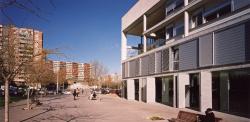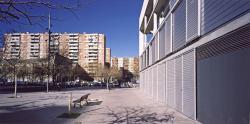There are two parts to the programme: sheltered dwellings for 24 residents and a day centre for the elderly.
The ground floor and half of the first floor are occupied by the day centre, and the sheltered dwellings occupy the rest of this floor and levels two and three.
One of the client’s basic requirements was to allow the building’s two programmes to function independently. The two foyers, though adjacent and communicable, therefore each have an independent entrance from the street. The day centre entrance is in the southern edge of the west façade and the street door to the dwellings is at the bottom of the opposite façade.
Given the project’s urban implantation, it seemed appropriate to situate the public part of the day centre’s programme in the west façade, overlooking the landscaped area that extends as far as Rambla Marina and bordering the pedestrian promenade. For this reason, of the two lengthwise bays into which each of the floors is divided, it is the west bay that accommodates the multipurpose hall (ground floor) and the programme of reading room, classroom-workshop, hairdresser’s, chiropodist, gym, computer room and offices (first floor).
The service areas of the day centre (kitchen, larder, refuse, cafeteria, staff changing rooms, etc.) are situated in the east bay on the ground floor, adjacent to the disused sports field and, therefore, away from the activity of the street. On the first floor, the east bay is occupied by the services of the sheltered dwellings (laundry-sewing room, maintenance and storage, kitchen, installations, etc.).
The actual dwellings occupy the second and third floors in their entirety.
The entrance to the sheltered dwellings is in the south of the east façade and, as needed, via the doorway of the day centre. The stairway and lift in the entrance nucleus are the only elements in the housing programme to be located on the ground floor.
On the first floor, the east bay accommodates the service spaces for this part of the programme (kitchen, larder, refuse, cafeteria and staff changing rooms), joined by a corridor that runs the length of the building’s east façade and, therefore, totally independent of the areas of the day centre on the same floor. Once again, the foyers of the two parts of the programme that share the first floor are adjacent so that they can be connected or left completely independent, as decided by the management.
The second and third floors respond to a similar layout. Both are occupied by sheltered dwellings.
Starting at the entrance foyer, where the stairway and lift are located, a central corridor forms the backbone of the floors. On the west side there are seven individual practicable dwellings and, in the east, one double and three individual accessible apartments. In the northwest of each floor, there is a living room that could also be used as a resident dining room. On the second floor, the living room opens up onto a terrace in the building’s west façade; on the third floor, it overlooks the double exterior space created above this terrace. The two superposed lounges are also interrelated by a small double space.
Each of the individual dwellings has a washroom, a small kitchen and a living-cum-bedroom. The washrooms and kitchens are laid out along the central corridor, freeing up the façades for living spaces. This not only makes the most of views and lighting, it also rationalizes the distribution of installations. In order to comply with regulations governing habitability in spaces containing toilets and kitchens, in all cases there are two doors between them.
The roof is accessible from the vertical communications shaft of the sheltered dwellings, which also contains the vertical distribution of the building’s installations. The installations machinery is situated on the part of the roof nearest this shaft.
2001
2004
.jpg)
.jpg)
.jpg)



LOW(1).jpg)
LOW(1).jpg)
LOW(1).jpg)
